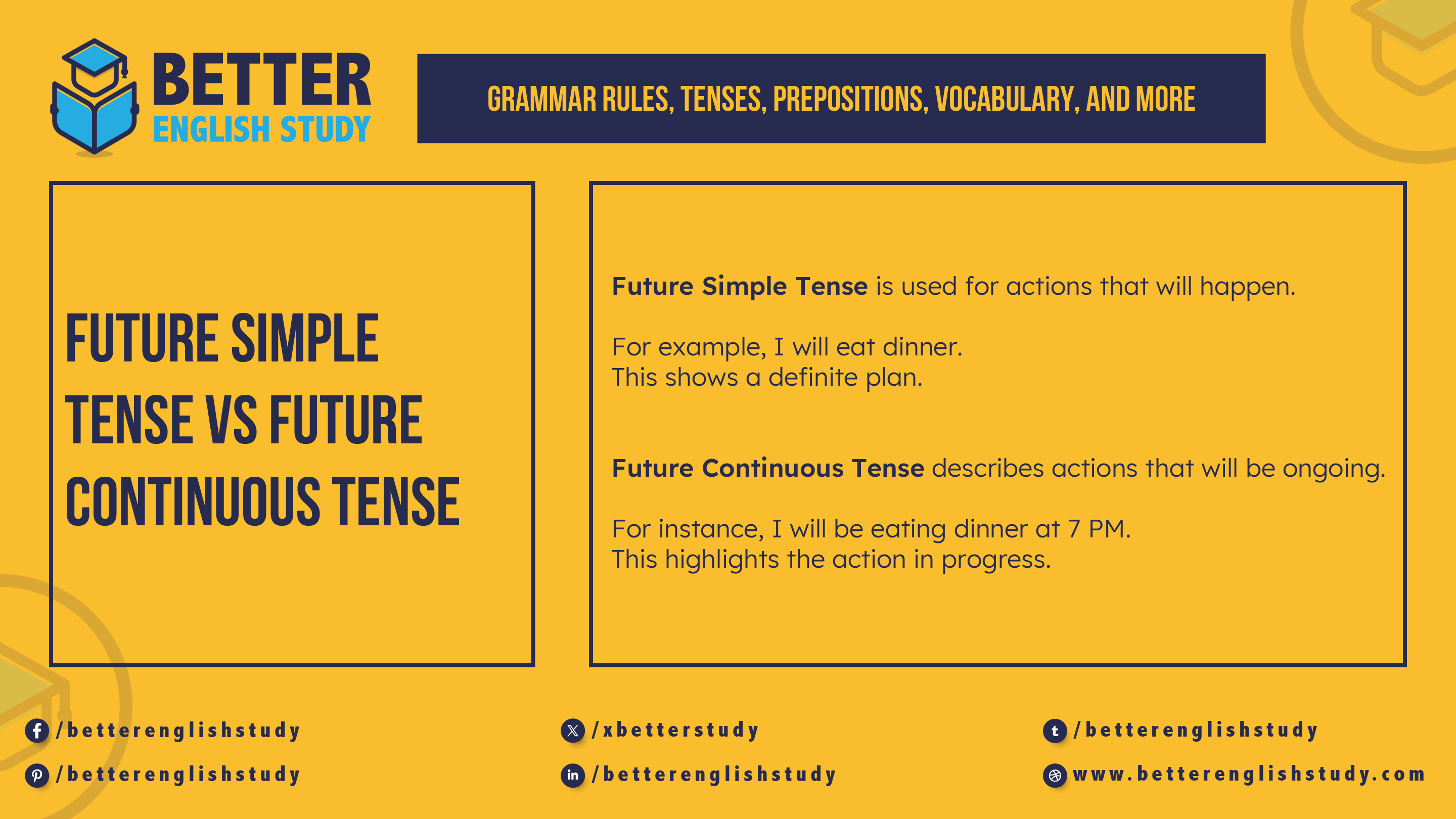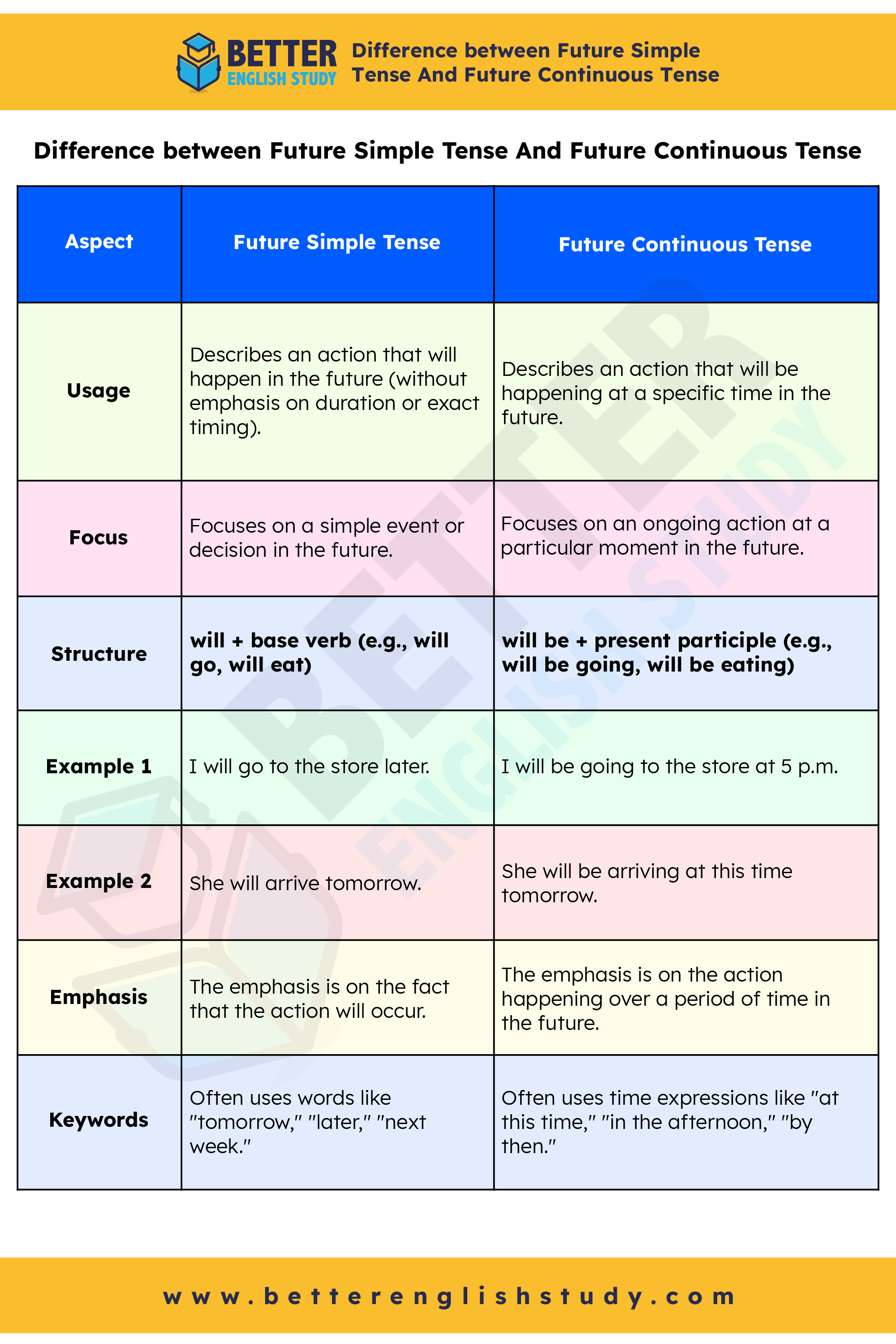
The Future Simple Tense expresses actions that will occur at a specific time, while the Future Continuous Tense indicates ongoing actions at a future time. For example, “I will eat dinner at 7 PM” (Future Simple) versus “I will be eating dinner at 7 PM” (Future Continuous).
Understanding verb tenses is crucial for effective communication. Among the various tenses, the Future Simple and Future Continuous play significant roles in conveying future actions. The Future Simple Tense focuses on completed actions, while the Future Continuous emphasizes the duration of an ongoing action in the future.
Mastering these tenses enhances clarity in both writing and speaking. This knowledge aids in expressing plans, predictions, and ongoing activities effectively.
Introduction To Future Tenses
Future tenses help express actions that will happen later. The Future Simple Tense describes actions that will occur at a specific time. For example, “I will eat dinner at 6 PM.” This tense shows a clear intention.
The Future Continuous Tense indicates actions that will be ongoing in the future. An example is, “I will be eating dinner at 6 PM.” This suggests that the action is in progress at that time.
Common confusions arise between these two tenses. The Future Simple focuses on a single action. In contrast, the Future Continuous highlights an action that spans time.
Both tenses play important roles in communication. Understanding their differences helps in using them correctly.
Basics Of Future Simple Tense
The Future Simple Tense is used to express actions that will happen later. It is formed using the modal verb “will” followed by the base form of the verb. For example, “I will eat” or “She will play.” This tense shows certainty about future actions.
Future Simple is often used for predictions, promises, or spontaneous decisions. For instance, “I will help you” is a promise. In another case, “It will rain tomorrow” is a prediction.
| Use Case | Example |
|---|---|
| Prediction | It will snow next week. |
| Promise | I will call you later. |
| Spontaneous Decision | I will answer that question. |
Diving Into Future Continuous Tense
The Future Continuous Tense shows actions that will be ongoing in the future. It often describes activities that will happen at a specific time. This tense is formed using the auxiliary verb “will” followed by “be” and the present participle of the main verb.
For example, “I will be playing soccer at 3 PM.” Here, the action of playing is ongoing at a future time.
Another example is, “She will be studying for her exams tomorrow.” This indicates that studying will be happening at that time.
| Structure | Example |
|---|---|
| Subject + will be + verb(-ing) | I will be reading. |
| Subject + will not be + verb(-ing) | He will not be sleeping. |
| Will + subject + be + verb(-ing)? | Will they be dancing? |

Difference between Future Simple Tense And Future Continuous Tense
| Aspect | Future Simple Tense | Future Continuous Tense |
|---|---|---|
| Usage | Describes an action that will happen in the future (without emphasis on duration or exact timing). | Describes an action that will be happening at a specific time in the future. |
| Focus | Focuses on a simple event or decision in the future. | Focuses on an ongoing action at a particular moment in the future. |
| Structure | will + base verb (e.g., will go, will eat) | will be + present participle (e.g., will be going, will be eating) |
| Example 1 | I will go to the store later. | I will be going to the store at 5 p.m. |
| Example 2 | She will arrive tomorrow. | She will be arriving at this time tomorrow. |
| Emphasis | The emphasis is on the fact that the action will occur. | The emphasis is on the action happening over a period of time in the future. |
| Keywords | Often uses words like “tomorrow,” “later,” “next week.” | Often uses time expressions like “at this time,” “in the afternoon,” “by then.” |
In summary, the future simple tense describes an action that will happen, while the future continuous tense describes an action that will be ongoing at a certain future time.
Illustrating With Examples
Understanding the difference between the Future Simple and Future Continuous tenses is essential for effective communication. The Future Simple describes completed actions, while the Future Continuous emphasizes ongoing activities at a specific time. Clear examples illustrate how these tenses function in everyday language.
Future Simple In Action
The Future Simple Tense describes actions that will happen later.
For example, “I will eat lunch.” This shows a plan for the future. Another example is, “She will play soccer tomorrow.” This indicates a future event. It focuses on completed actions.
Future Continuous In Action
The Future Continuous Tense describes ongoing actions in the future.
For instance, “I will be eating lunch at noon.” This highlights an action in progress. Another example is, “They will be playing soccer at 3 PM.” This shows a future activity in motion. It emphasizes the duration of the action.
Practical Applications
Future Simple Tense is used for actions that will happen. For example, “I will eat dinner.” This shows a definite plan.
Future Continuous Tense describes actions that will be ongoing. For instance, “I will be eating dinner at 7 PM.” This highlights the action in progress.
In everyday conversations, using the Future Simple Tense is common. People say, “I will go to the store.” This is clear and direct.
In academic and professional settings, the Future Continuous Tense can add detail. For example, “We will be discussing the project tomorrow.” This gives more context about the timing.
Frequently Asked Questions
What Is Future Simple Tense?
Future Simple Tense expresses actions that will happen in the future. It is formed with “will” followed by the base form of the verb. For example, “I will eat dinner. ” This tense is often used for predictions, promises, and decisions made at the moment.
What Is Future Continuous Tense?
Future Continuous Tense describes actions that will be ongoing at a specific time in the future. It is formed with “will be” plus the verb ending in “-ing. ” For instance, “I will be eating dinner at 7 PM. ” This tense emphasizes the duration of an action.
How Do Future Simple And Continuous Differ?
The primary difference lies in their focus. Future Simple emphasizes a completed action, while Future Continuous highlights an ongoing action. For example, “I will read a book” (Simple) versus “I will be reading a book” (Continuous). This distinction helps convey different meanings in context.
Can Future Simple And Continuous Be Used Together?
Yes, they can be used together in sentences. For instance, “I will be studying while you will be working. ” This combination clarifies the timing and nature of actions. Using both tenses adds depth to your communication and enriches your language skills.
Conclusion
Understanding the difference between the Future Simple and Future Continuous tenses is crucial for effective communication. Each tense serves a unique purpose in expressing time and action. By using clear examples, you can master these tenses. Practice using them in your writing to enhance clarity and precision in your language skills.
